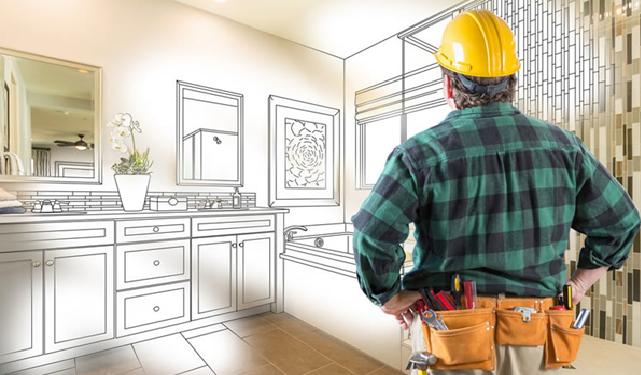The Ultimate Guide to Follow for the Complete Home Renovation

When you renovate your house it can be both exciting and daunting, from finding out the stuff which is hidden under years’ worth of dust or adding something new. The success of house renovation relies on being prepared for what lies ahead and, to a certain degree, an expectation that there will be some surprises.
House improvement can bring about a set of issues that will need to be fixed before your dream home can finish — and these issues tend to include unknown costs. Being alert of these issues and having a step-by-step plan of action should mean the project remains on schedule and budget.
Are you considering renovating your house? Don’t start until you have read our complete guide. From finding and buying a project to putting the final decorations to your home – this blog has covered it all.
Ask yourself do I need an architect?
When you renovate your home, one of the essential decisions you need to make is whether you need an architect or not. It can cost a big impact on the budget and quality of the work. Many people think that producing a house design for an existing house is trickier than starting it from the beginning.
But the question is how you will know that you need an architect. So here are a few things which will help you in deciding whether you need them or not.
- If you don’t know what you want, then an architect can help you.
- They will help you in managing the whole process.
- If you hire contractors, some of them can handle all major works that include whole house extension and renovation while some of them can only do small tasks such as redoing a bathroom.
- If you’re getting a qualified architect, then make sure they must be registered with the Architect Registration Board that has a database which can be accessed publicly.
- They must have the Professional Indemnity Insurance to protect their clients and are also subject to a statutory code of practice.
- Moreover, if you hire an architect, then you will end up with a better end product.
Once you’ve design ready for your house which is approved, you should create a work schedule to ensure that you’re carrying out improvement in a logical way to minimise disruption and duplication.
The work schedule for renovation
At the time of renovation, a work schedule is essential. It outlines every single job that needs to be done from start to finish of a project, in proper order. Moreover, you also need to include who is doing what and how much it will cost.
Here is a typical work schedule for house improvement, although yours might look a bit different. When you hire a house designer or builder they will be able to advise you more.
- House inspection and further decay
- Grants, permits and tax concessions
- Statutory consents and structural stability
- Demolition work
- Dealing with damp and drains
- Site access
- Major building work
- Weather tight
- Exterior and External works
- First fix i.e. plastering, drying out and fixed flooring
- Second fix i.e. decorating
- Final clean
- Move-in
- Snagging
Planning permission for renovations
There are several things which you need to check before you start your renovation that includes planning permission, listed building consent and building regulations approval. To avoid delay, you can start working on the project which doesn’t require any kind of permission.
Also, remember if you want to start your work within 24 hours you can take approval from the building regulation that is given by the local authority of the building control department. Consider the small alterations like:
- Replacing rainwater goods
- Replacing or repainting the timber work across your house
- To add character consider adding a porch
- Landscaping includes gates, fences and planting
- Brickwork painting.
Which original feature do you want to save?
For many people, one of the biggest appeals is likely to incorporate original features that may still be in place. All of which you can add to the character and charm of old buildings.
Sadly, not all projects which are for renovation will have survived years without care intact, meaning original features might be missing or damaged. Work on some of the features which are worth saving and to avoid unnecessarily spending money.
In some cases, the cost of repair work doesn’t practically make sense and you may need to consider sourcing sympathetic, matching replacements. However, unless you’re prepared to spend more, these replacements may not capture the fine detailing of the originals.
To retain the original feature of your renovation project, there are certain features which you should pay attention that includes floors, doors, fireplaces, roofs, timber beams, windows and original mouldings.
Create site access
If you’re staying in the area where the site is with restricted access, it is a good idea to plan. Get any large items or machinery in for landscaping on to the plot, before access is further obstructed by new building work and stored materials.
Knocking down internal walls
An element of structural change will be necessary to make the house suitable for modern-day living. Period houses were often designed to incorporate lots of smaller spaces and may have been subject to notch and potch of ill throughout the additions over the years, in short, the general flow of the layout can be left lacking.
Should I create a snagging list?
Small problems will unavoidably crop up over the later months. Fix these problems as soon as they come or else if you used tradesmen, call them back. Although expect to have to pay them for the defects that are not their fault such as plaster crack or drain lock.
Interior design
The painting and staining work should begin once all work is completed to ensure the building is clean and dust-free. Else it will be difficult to get a good finish. Kitchen and bathroom wall tailing can now be carried out.
At last, once all tiling work is done you’re now ready to fit your shower enclosures and doors. In the final stage, once decorating is done, any soft floor coverings, such as vinyl and carpet can be laid and goods like hob, oven, washing machine and fridge can be fitted.
How much extra will be an extension cost?
Old properties don’t always provide the space modern-day homeowners expect and in this case, a house extension will be necessary.
Ground condition, site access, interior, location and proximity of services, size and designs, will also affect the cost of extension. As this is a rough guide, the structural side of the project will take up about 60% to 65% of the total expenditure, whilst fittings will use up the remainder.
Conclusion
Even if you didn’t decide any future home improvement project like kitchen renovation, bathroom renovation or installing a deck in your backyard, it’s wise to set some money aside every year for remodelling. Moreover, when you think to install a deck there are certain dos and don’ts of composite deck installation. It is also essential to maintain a home improvement calendar to keep your home tip-top and in shape all year round.
Author Bio:
Hi, I am Mike Morleye. As a professional writer, I put together my writing skills to share knowledge on diverse topics in a readable, understandable and appealing format.






